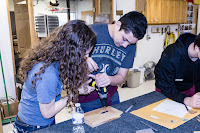This weekend the team was brought back together to make further progress on the aircraft. Many exciting things took place, including the installation of the engine. Some other key points that were made during this class is the shaping of the cowling head.
Before
The engine still had some further prep work that was needed before the actual installment. Things like making sure that the wiring harness that connects to the engine is fully in place, that the tubing on the engine is fully secured and routed, and that we have all hardware in means of placement.
After
The engine was officially attached to the fuselage! This exciting moment goes down as an substantial progress for Teen Flight 4. Getting everything set and connected to the engine from the fuselage is now the next priority for this group.
Cowling head
When it comes to shaping the cowling it is very important to remember when shaving it down from its original form, keep in mind that it's better to not take off too much at once. It is better to take off less material than more, If too much material is removed it's impossible to back track. Better safe then sorry. Measuring each piece to one another is also crucial, making sure that you are taking off as close to the right amount as possible. Not only this, but making sure they fit in uniform with the aircraft, as this is considered part of the 'frame'.
As to the physical aspects that are coming in place
Mentors and students make their way with some filing, helping with these pieces to not have too rough of edges when built along in the process.
Being a student in this class, it takes my breathe away seeing this progress further towards our finished product. Along the way we learn many skills and tips that are beneficial to our education with material objects. Applying that knowledge and using it physically to create something of excellence is all the while worth it. Dedicating our time every Saturday to learn.
Friendly indeed, for needs may come. As a team we are one.













































